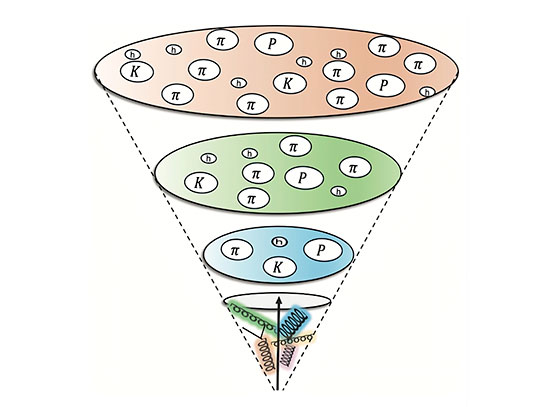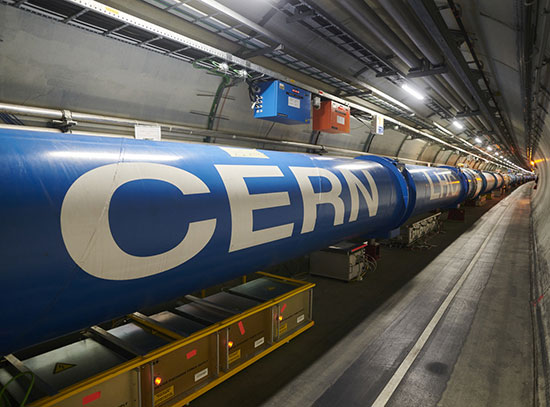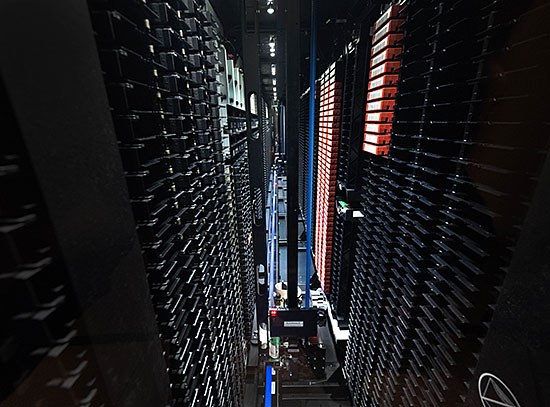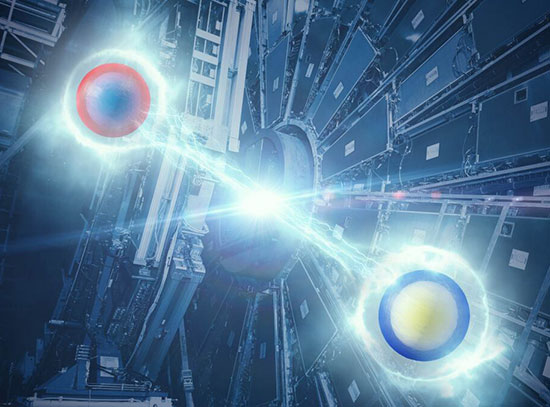Alternative Futures in High-Energy Particle Physics
Scientists convene at Brookhaven National Laboratory to plan new projects and anticipate scientific discovery
April 16, 2013
By Angela Leroux-Lindsey
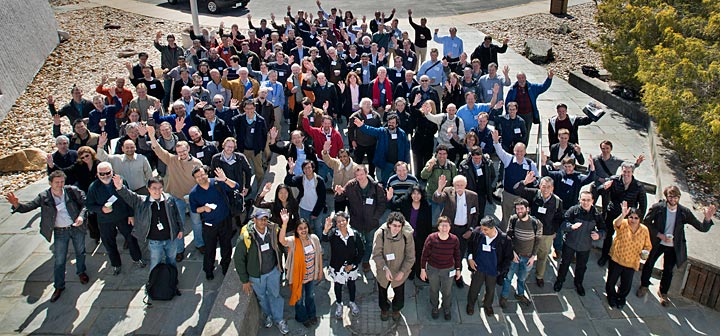
 Attendees at the Snowmass high-energy frontier workshop gather at Brookhaven National Laboratory to discuss the future of high-energy physics.
Attendees at the Snowmass high-energy frontier workshop gather at Brookhaven National Laboratory to discuss the future of high-energy physics.
In an exultant moment for an entire generation of high-energy particle physicists, the long-sought-after Higgs boson—an elementary particle predicted to endow other elementary particles with mass—was cemented as an experimental discovery in March, completing the Standard Model of particle physics and bringing new insight to our mysterious and enthralling universe. This historic breakthrough culminated more than four decades of scientific inquiry, and is a triumph of the largest international collaborative endeavor in the history of science: The Large Hadron Collider (LHC), a powerful particle collider operating in Europe that is host to more than 10,000 scientists from all over the world.
Brookhaven National Laboratory was an active participant in the Higgs discovery and physicists here continue to sift through and analyze data as it comes in from the LHC. Brookhaven researchers helped build ATLAS, one of the LHC detectors, and Brookhaven is now the U.S. host laboratory for this experiment, playing essential roles in the project's operation, physics analysis, upgrades, and computing. Brookhaven also has a long history of innovation in physics, as five Nobel prizes in high-energy physics in the last half-century have been awarded for work done at the Lab. The Higgs detection is just the latest insight from a field that continuously unveils new data about the subatomic realm, but it may be the most profound. Further study of its properties and behavior promises to bring excitement and resolution of current questions to the next several decades of research.
An accomplishment of this magnitude requires brilliant theoretical insight, grand experimental execution, meticulous data analysis, and—equally important—careful planning. To this end, once every decade or so, the U.S. cohort of high-energy physicists convenes at a conference called Snowmass, an opportunity for scientists to discuss how to maximize the effectiveness of future experimental projects. In early April, Brookhaven hosted the first of two Snowmass meetings dedicated to scientists working in the "energy frontier" study group, a subset of the high-energy community interested in areas of particle physics that are most relevant to high-energy colliders and in mapping the opportunities they present for future discoveries.
"At Snowmass, we have an opportunity to solidify the considerable excitement we see in physics," said Howard Gordon, deputy chair of the BNL Physics Department and deputy collaboration board chair of the ATLAS experiment. "The Higgs boson is very important because of its role in giving elementary particles their mass, and learning more about it will be critical to our understanding of nature."
The major items on the table at Snowmass revolved largely around the Higgs and how to more closely study it. Beginning in 2015, the LHC will collide particles at higher energies than ever before, and will likely yield more precise data on the Higgs mass and other properties. Beyond that, the possibility of a next-generation machine called the International Linear Collider (ILC)—which would collide electrons instead of protons, producing cleaner and more robust collision events—has people in the field buzzing.
"After the LHC, what do we want to do in the future? Do we want to keep building larger, more powerful accelerators? And what do we know now that could provide physics motivation for doing it? These are the issues being debated this week," said Michael Peskin, a theoretical physicist at SLAC National Accelerator Laboratory and co-convener of the energy frontier workshop. "There are still big physics questions that we're probably just about to find the answers to. The exciting thing is that these answers could well be found in the next stages of the LHC program and at the ILC."
The Higgs Boson is a part of the Standard Model of particle physics, but this aspect of the Standard Model has always seemed mysterious and incomplete. A tantalizing aspect of the Higgs discovery is that it gives particle physicists a path to confront these problems with experimental data and discover missing pieces of the story. Scientists already know that the Standard Model isn't totally comprehensive, since it leaves out explanations of gravity, dark matter, and dark energy. Some physicists at Snowmass revel in the possibility of beyond-Standard Model physics and hope that future accelerator runs will produce even more evidence to support it.
"We no longer have the luxury of knowing that we're operating within the Standard Model," said Chip Brock, former chair of the physics department at Michigan State University and co-convener of the energy frontier workshop. "All of a sudden, we've lost that mooring, because now we have an experimental confirmation of a measurement that says there must be something beyond it. That's really exciting."
Global collaborations like the LHC may be the model for all future projects, including the ILC, which—if built—would require scientific and monetary contributions from countries across the globe. Japan has already expressed interest in moving forward with plans to build the ILC, but only with the support of other physics communities. Many U.S. physicists are hopeful such support will materialize, and believe in the promise of new physics.
"I think the Higgs is the tip of an iceberg," said Jonathan Rosner, a professor of physics at the University of Chicago. "Its connection with dark matter is just beginning to be realized, and I would say that whatever lies beyond the Standard Model is related both to the Higgs and to dark matter—and possibly even to why we have so many quarks and leptons."
However, not everyone agrees that beyond-Standard Model physics is out there, adding friendly debate to the Snowmass discourse.
"The Higgs boson is a huge accomplishment, and just the beginning as we continue to analyze the data and try to figure out what's really there," said Sally Dawson, a senior scientist in the Physics Department at Brookhaven and organizer of the energy frontier workshop. "But my prediction is that the Higgs boson is the whole story. I know that's an unusual prediction, but I think the Standard Model is going to be it—and now we just have to prove it."
This possibility is certainly something the group will consider when finalizing a proposal for future projects. At $10 billion a pop, colliders like the LHC and those physicists are now contemplating aren't easy to come by. Sorting out critical disagreements within the field is precisely what Snowmass is designed to facilitate, in the hopes that by the end of this summer, a coherent view of future priorities will emerge. Brookhaven will host the next workshop group, which will focus on possible future accelerator projects in the intensity frontier, starting on April 17.
Fueled by the Higgs success story, the heartbeat of high-energy physics remains an insatiable curiosity about the universe and a sense of wonder that drives the field toward new and bigger breakthroughs. This particular moment in physics could mark the edge of a paradigm, and allows for big ideas as scientists look toward a wide-open future.
"Any way you look at it, particle physics from this point on is historic," Brock said. "We're trying to imagine a discovery of sorts we haven't seen before. We're dreaming about what new physics should be."
2013-3838 | INT/EXT | Newsroom



